SCOUTING TRIP NOTES
SINGAPORE and INDONESIA
Including Northern Sulawesi, Bali and Flores
June 5 - July 3, 2014
© 2014 Callyn Yorke
Spectral Tarsier (Tarsius tarsier) Tangkoko National Park, Sulawesi 17 June 2014
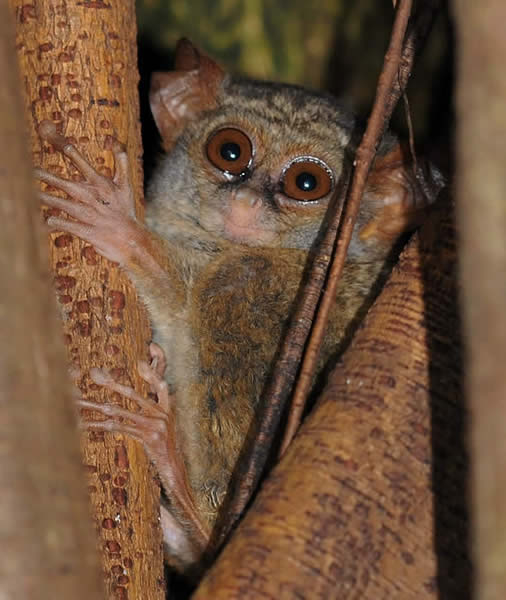
© 2014 Callyn Yorke
INDEX TO LINKS
Entries From My Travel Journal
REPORTS
Bunaken Island Diving (June 7-12, 2014)
Singapore Birds (June 5, 2014)
Northern Sulawesi Birds (June 7-21, 2014)
Flores, Rinca and Komodo Island Birds (June 23-30, 2014)
Map of the Indo-Malayan Archipelago; Inset shows location of Bunaken Island and adjacent areas I visited in Northern Sulawesi
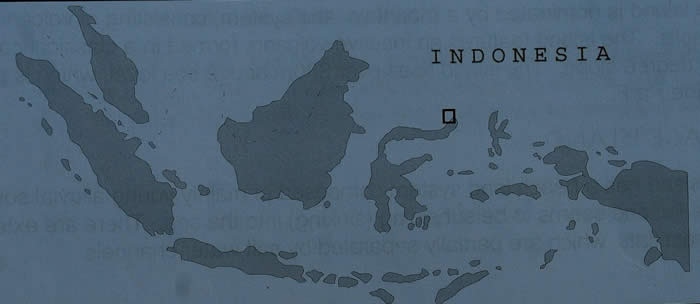
There are no direct flights from Los Angeles California to Sulawesi. My journey involved three international flights, LOS ANGELES to TOKYO; TOKYO to SINGAPORE; SINGAPORE to MANADO, for a total flight time of about 19.5 hours. The first flight was 10 hours; the following two, each about half as lengthy (i.e. 5.5 hrs. and 2.5 hrs. respectively). A 24hr. stop-over in Singapore was a welcomed relief. I spent the morning birding the Singapore Botanical Garden and had a fine meal at the historic Raffles Hotel. The next morning, actually two days after I left L.A. due to crossing the international date line, I paid a whopping $175 excess baggage fee (non-negotiable) and borded a partly empty Silk Air flight to Manado, the largest town in north Sulawesi. One more connection now -- a forty-minute boat trip to Bunaken Island. Soon I had arrived at the Living Colours Resort and moved into a comfortable bungalow overlooking the ocean. This tranquil and secluded dive resort was a world away from the bustling metropolises of Los Angeles and Singapore.
Landing at Living Colours Dive Resort Bunaken 6 June 2014 Living Colours Bar ("Safety Stop") 10 June 2014
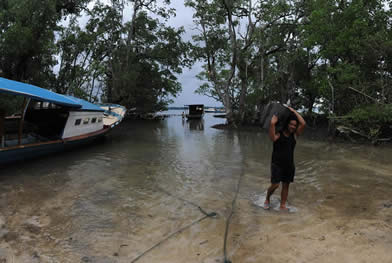
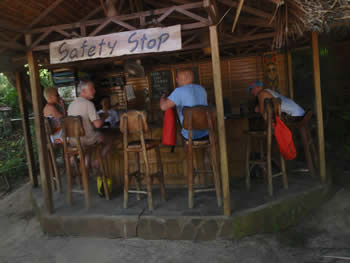
© 2014 Callyn Yorke
Bungalow #1 Living Colours Resort Bunaken Island, North Sulawesi 6 June 2014
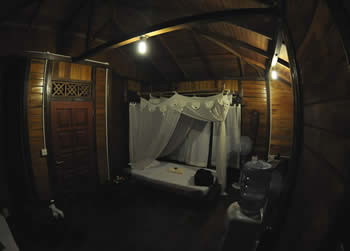
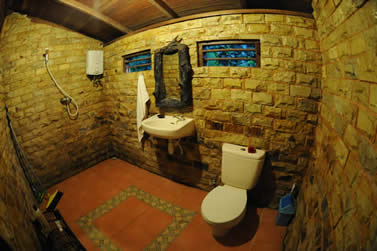
© 2014 Callyn Yorke
Pink Skunk Anemonefish (Amphiprion perideraion) @ 45 ft. Bunaken Island 10 June 2014
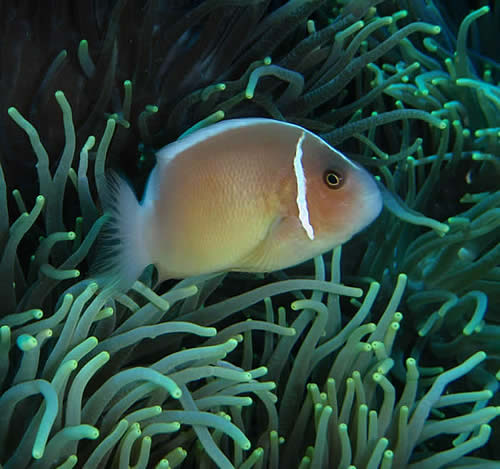
© 2014 Callyn Yorke
My plan for the first week of a month-long scouting trip, was to see if Bunaken Island lived up to its reputation for having some of the most diversified coral reef communities on the planet. I was not disappointed. Over the next six days I made a total of eleven dives, each at a different dive site, each with an astonishing variety of sponges, corals, echinoderms, tunicates, turtles and fishes. All of this biodiversity comprised one of the healthiest reef communities remaining on the planet. We are talking water visibility of 30-90 ft. and luxurient walls of coral plunging into the abyss, sometimes more than a mile. My fish list included at least 120 species, representing about twenty families. Not surprisingly, the Indonesian government has designated Bunaken, its adjacent waters and islands, a National Park. National treasure certainly would not overstate its value (see Bunaken Dive Report).
Map showing some of the dive sites around Bunaken and Manadotua Islands
Sites I dove included, Mike's Pt., Sachicko's Pt., Bunaken Timur 1, Muka Kampung, Fukui, Mandolin and Negeri

The next phase of my trip would be an exploration of mainland Sulawesi, predominantly the northern section around Manado. I enlisted the help of a local guide and driver to facilitate the safari. Sulawesi has a good infrastructure of roads and accomodations with relatively few tourists. In most cases, we could simply drift into a small town or village and find a room for one to several days.
Map showing birding sites I visited in Northern Sulawesi
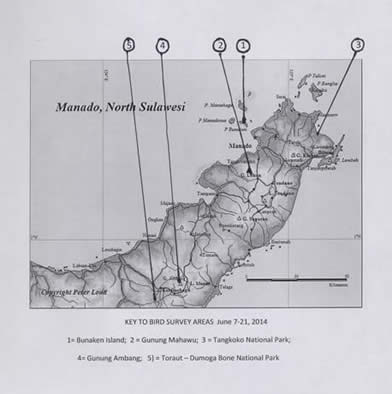
My birding pal, Christo, had already arranged our itinerary when I arrived at Bunaken. He met me at the dock in Manado, with Kiki, his brother-in-law, whom agreed to be our driver. Our first stop was an ATM, of which there are plenty in Manado (and elsewhere in Sulawesi). The conversion rate for US Dollars was about 1: 11,400 Indonesian Rupiah. Since the biggest currency denomination is a 100K Rupiah note (roughly $10), it seemed I would be carrying around a backpack full of cash just to cover basic food and transportation. And there was another inconvenience. Sulawesi ATM's dispense a maximum daily withdrawl ranging from US $50-$100. Fortunately, Most hotels and large stores accept VISA, which becomes pretty much a necessity for transactions exceeding $100. The good news: Sulawesi is much less expensive than Singapore. For example, deluxe accomodation on the Sulawesi mainland can be obtained for $50-60 US per day. Food is ridiculously inexpensive; a full, three-course Indonesian-style meal costs less than $5. Public transportation is just pennies per mile. Long-term drivers will negotiate reasonable prices for their service. Car rental is available for about $60 per day, but I wouldn't recommend it to anyone lacking driving experience in the region.
Christophorus Merung Tangkoko National Park, Sulawesi 17 June 2014
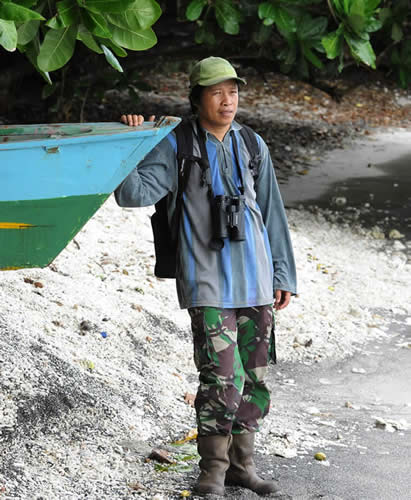
© 2014 Callyn Yorke
Christo was the go-to guy for just about all of our needs. In addition to making logistic arrangements for us, he demonstrated expertise in natural history and especially Ornithology. Christo instantly identified the majority of birds we encountered and knew the Latin binomials for all of the Sulawesi birds (about 500 species). He had received his training while working for several international conservation organizations in Indonesia, including The Wildlife Conservation Society and The Nature Conservancy. If that wasn't enough, he and his brother in law, Kiki, provided a daily Bahasa Indonesia refresher course for me as we toured the countryside.
The Indonesian language is basically the same as Malay. Notable differences occur, however. Some of their shared words, e.g. Bisa and Boleh, carry quite different meanings (the former word means poisonous, as in snake venom, in Malay; and can, as in able to do something, in Bahasa Indonesia). Misuse of the non-interchangable words between Malay and Indonesian must be common, because I was seldom corrected for it.
A few days chatting with the staff at the Living Colours resort, followed by frequent conversations with Christo and Kiki, and I began speaking the Indo-Malay language again, which had been dormant in my memory for more than thirty years. Though semi-fluent in Malay by the time my three year Peace Corps Malaysia stint was over in 1980, I was now reduced to the level of an ambitious, bubbly, two-year old, grasping for words out of nowhere, like remarks made by former president George W. Bush as he gazed at a map of the world, Wow, Brazil is really big! Christo, Kiki, and nearly every native speaking Indonesian I met on this trip, seemed delighted that I was stumbling comically through their lovely language, while attempting to put sophisticated ideas across such as, It looks like rain again this evening. Luckily, grammar for spoken Bahasa Indonesia is wonderfully simple. For example, verbs are all in one form. A sentence in English such as, I am going to sleep now, translates in Bahasa simply to Saya tidur. No matter how I put the words together, Christo and Kiki understood what I meant.
Accomodations in northern Sulawesi ranged from clean, comfortable and modern (e.g. The Highland Resort near Gunung Mabawu) to dilapidated, termite-infested, moldy, bedbug infested rooms (e.g. the old WWF research station near Toraut). The 240 volt electrical outlets in the WWF station were so loose, that I was unable to get anything but a buzzing shock when attempting to plug in my laptop. A homestay near Gunung Ambang was infested with mosquitoes (probably Anopheles), and incessant loudspeakers blasting music from a nearby wedding reception, lasting into the early morning hours. The final straw for me was the homeowner's fee for one night's stay,including an tea, snacks, Indonesian-style dinner and breakfast, which was equivalent to about two months of his salary as a park ranger.
Nevertheless, we ended our one-week tour of northern Sulawesi with a lengthy bird list, including many endemic species (e.g. Sulawesi Hanging Parrot, Yellow-billed Malkoa, Yellow-sided Flowerpecker), all of which were life birds for me. A special treat was observing at close range, two Sulawesi specialities, Spectral Tarsier and Crested Macaque. Although rain and poor lighting under the forest canopy prevented much photography, I was occasionally able to capture images of birds and other wildlife using a Nikon D3X (a rugged and water-resistant camera body) and Nikkor AF VR 80-400mm lens. For night-time and dim light photography, including some close-up shots, I used the same Nikon D3X fitted with a R-21 dual ring flash and Nikkor AF 200 mm lens. Some of my general photography (e.g. the Tomohon market) was done with the Nikon D3X and a Nikkor AF fisheye lens.
Sulawesi Hanging Parrot Gunung Mabawu Sulawesi 14 June 2014
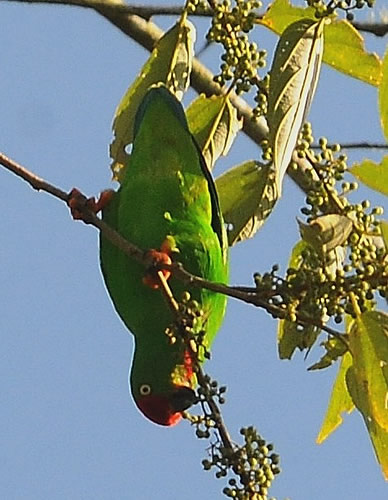
© 2014 Callyn Yorke
Yellow-billed Malkoa Gunung Mabawu Sulawesi 14 June 2014 Yellow-sided Flowerpecker Gunung Mabawu 15 June 2014
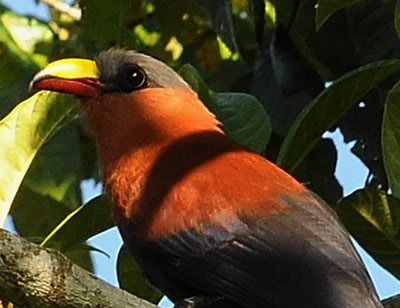
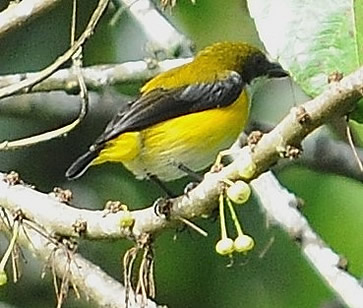
© 2014 Callyn Yorke © 2014 Callyn Yorke
Crested Macaque (Macaca nigra) Tangkoko National Park Sulawesi 17 June 2014
© 2014 Callyn Yorke
Tomohon market Sulawesi 14 June 2014 Lukon volcano (near Gunung Mabawu) Sulawesi 14 June 2014
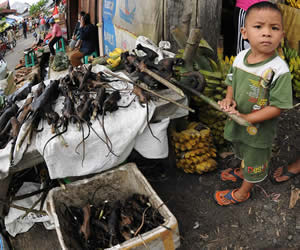

© 2014 Callyn Yorke